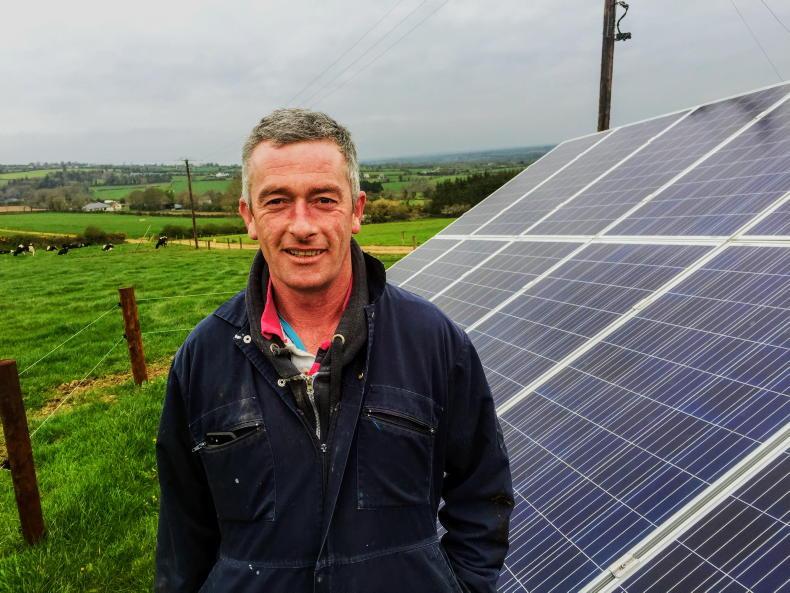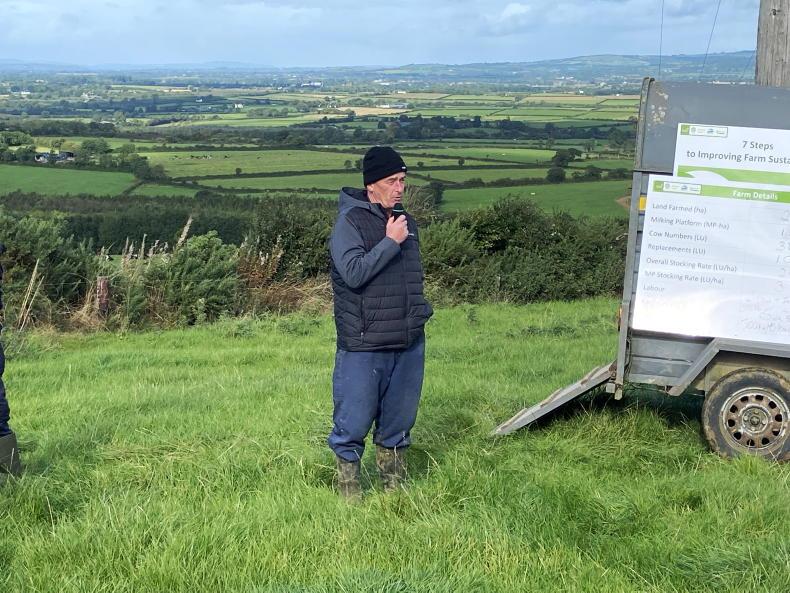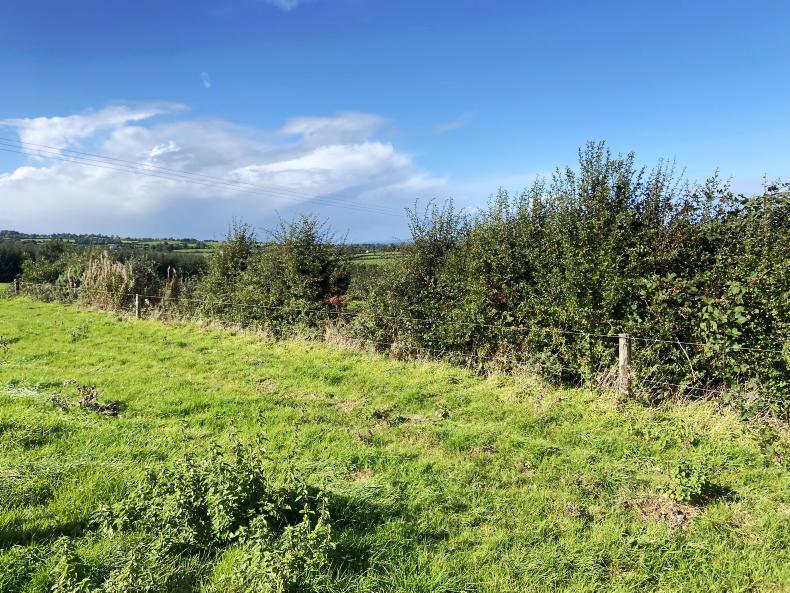Glanbia Ireland and Teagasc held their first joint programme farm walk in almost two years last Friday.
The host was Cathal Moran who is milking 380 cows on a 585ac farm at Skeoughvasteen in Co Kilkenny.
The current joint programme was established in 2019 and is now set to continue for another five years under the Teagasc Signpost Farms banner.

Dairy farmer Cathal Moran next to solar panels installed on his farm in Skeoughvosteen, Co Kilkenny. \ Thomas Hubert
There was a big emphasis on the environment at the Moran farm walk. With 118ha in the milking platform, the stocking rate is 3.2 cows/ha.
Cathal grew 13.5tDM/ha last year and spread 270kgN/ha on the milking platform and 220kgN/ha across the whole farm this year. The new target for the farm is to grow 15tDM/ha from 150kgN/ha by incorporating clover across the farm.
Cathal acknowledged that the farm is very prone to drought and so this has a big impact on grass growth rates.
This year was a case in point as he only stopped feeding silage last week, having been feeding silage for the previous seven weeks due to grass deficits.
The average farm cover is now 993kg/ha, so it’s still not at target levels. Growth rate last week was 54kg and demand is 42kg with 3kg of meal being fed per cow. The herd delivered 455kg MS/cow last year.
“Plans for future growth are now on hold due to outside influences and so we are heading into a period of consolidation. As the herd matures we’re likely to get more output out of the cows. We think there’s 10% more output in them but with some long walks and a hilly farm it’s hard to know if that will be realised or not,” Cathal said.

Cathal Moran speaking at the Teagasc/Glanbia farm walk on his farm.
At this stage, 47% of the farm is optimum for pH, phosphorus and potassium whereas, in 2015, none of the farm was at optimum level for all three metrics.
Soil pH and potash levels are generally good at 94% and 86% on target, respectively. Phosphorus is proving more challenging, with 38% of the farm still at index one and two.
The EBI of the herd is €188, with €41 for milk sub-index and €108 for fertility sub-index.
The average EBI of the team of 10 bulls used this year was €331. The six-week calving rate is 86% and the empty rate for the cows after 11 weeks of breeding was 6.8%, which is excellent performance.
Biodiversity
Aoife Leader from Teagasc spoke about biodiversity on the Moran farm. She said that 10% of the Moran farm is beneficial for biodiversity whereas the average of the joint programme farms is 8.5%.
However, only the owned portion of the Moran farm was measured, which is about 25% of the overall farm.
Within this, there are 9km of hedgerows which cover 3% of the owned land.
The other 7% of land area beneficial to biodiversity is the large farmyard and a grove of trees.
Aoife said that farmyards can be a habitat for birds and that Cathal is planning to plant hedgerows around it and make some landscape features.
Average field size on the Moran owned land is 7ha and she said that the target here is for field sizes to be less than 5ha.
“It’s very easy to measure this – just count all the fields on the farm that have a hedgerow or other linear biodiversity feature and divide this by the overall farm size.
“The range among the Future Farmers [joint programme] is between 3ha and 14ha, while a study on dairy farms in Waterford found the range to be between 1ha and 36ha.
Reducing the average field size will create more corridors for nature,” Aoife said.
She had timely advice for farmers planning hedge-cutting this autumn.
She said the key thing is to make sure farmers and contractors are on the one page because it can often happen that the contractor thinks they are doing what the farmer wants, which may not be the case, so good communication is key to avoid confusion.
Hedges should be kept as high as possible, at least 1.5m from the base to encourage birds to nest in the hedge because most birds won’t build nests too close to the ground where they can be attacked by rodents or predators.

The plan is to bring out the wire 1.5m from the edge of the hedgerow.
She said breasting or side-cutting is better than cutting the tops. Hedges should be trimmed in an A-shape rather than square shape as the tip of the hedge provides a song post for birds and it leaves in more light to the base of the hedge.
Pat Moylan from Teagasc reminded derogation farmers of the new rules around hedge-cutting.

Pat Moylan and Aoife Leader from Teagasc speaking at the biodiversity stand.
Farmers can either cut hedges on a three-year rotation or leave a whitethorn or blackthorn hedge every 300m.
He said that some farmers are marking the plants to leave by putting tape on them so the hedge cutter driver can see them easily.
The purpose of leaving whitethorn or blackthorn trees mature is that they flower in spring, which provides nectar for pollinators and they produce fruit in autumn which provides food for birds over the winter.
Cathal’s carbon footprint has been measured at 0.94kgCO2e/kg fat and protein corrected milk (FPCM).
Jonathan Herron from Teagasc said that the average in Ireland is 1kgCO2e/kgFPCM. The target for Cathal is to produce milk with a carbon footprint of 0.8kgCO2e/kgFPCM, a 15% reduction.
Cathal is using LESS when spreading all of his slurry, 50% of the nitrogen applied is in the form of protected urea and, as mentioned, he has a high-EBI herd.
He plans to increase milk solids to 500kg MS/cow, reduce replacement rate from 31% to 18%, adopt 100% protected urea for nitrogen fertiliser and reduce fertiliser use to reduce carbon footprint.
As the first in a series of Signpost dairy farm walks, there was a big emphasis on the environment at this event. Production and profit took a back seat. Did it deliver for the farmers in attendance? I’m not so sure.
Two well-intentioned ASSAP advisers spoke for what seemed like 40 minutes about water quality in Kilkenny but it was laced with unnecessary detail and failed to deliver the sucker punch on what farmers need to do to improve water quality in three or four key points.
The suggestion that a farmyard is a biodiversity-rich area is news to me.
Why wasn’t the whole farm measured for hedgerows and habitats and not just the owned land? If the story is good or bad, we should hear it as it is and tell farmers how to maintain or improve it.
The current and future profitability of the farm wasn’t discussed, nor were the implications of the new Glanbia penalties on peak milk supply.
Older iterations of joint programmes always delved into profit, which is where most of the lessons and learnings come from but profit is discussed less and less at farm walks now. Why? Grassland management tips for the autumn weren’t discussed either.
Balance
I fully agree with the principle of incorporating environmental factors into farm key performance indicators – it’s essential. However, it needs to be balanced, it needs to be real and it needs to be honest. Otherwise, those attending will just tune out.
Farmers who open their gates to visitors do the industry a great service and for that we are all grateful. It’s the task of those organising these events to make sure that they are relevant to those who attend.
Cathal Moran is milking 380 cows on a 237ha farm at Skeughvasteen in Co Kilkenny.He’s currently growing 13.5tDM/ha from 270kgN/ha on the milking platform but aims to grow 15tDM/ha from 150kgN/ha in the future. Hedgerows are left grow to 1.5m high and Cathal plans to plant more hedges in the future. The plan is to reduce the farm’s carbon footprint through reducing fertiliser, increasing milk yield, switching to protected urea and improving animal health.
Glanbia Ireland and Teagasc held their first joint programme farm walk in almost two years last Friday.
The host was Cathal Moran who is milking 380 cows on a 585ac farm at Skeoughvasteen in Co Kilkenny.
The current joint programme was established in 2019 and is now set to continue for another five years under the Teagasc Signpost Farms banner.

Dairy farmer Cathal Moran next to solar panels installed on his farm in Skeoughvosteen, Co Kilkenny. \ Thomas Hubert
There was a big emphasis on the environment at the Moran farm walk. With 118ha in the milking platform, the stocking rate is 3.2 cows/ha.
Cathal grew 13.5tDM/ha last year and spread 270kgN/ha on the milking platform and 220kgN/ha across the whole farm this year. The new target for the farm is to grow 15tDM/ha from 150kgN/ha by incorporating clover across the farm.
Cathal acknowledged that the farm is very prone to drought and so this has a big impact on grass growth rates.
This year was a case in point as he only stopped feeding silage last week, having been feeding silage for the previous seven weeks due to grass deficits.
The average farm cover is now 993kg/ha, so it’s still not at target levels. Growth rate last week was 54kg and demand is 42kg with 3kg of meal being fed per cow. The herd delivered 455kg MS/cow last year.
“Plans for future growth are now on hold due to outside influences and so we are heading into a period of consolidation. As the herd matures we’re likely to get more output out of the cows. We think there’s 10% more output in them but with some long walks and a hilly farm it’s hard to know if that will be realised or not,” Cathal said.

Cathal Moran speaking at the Teagasc/Glanbia farm walk on his farm.
At this stage, 47% of the farm is optimum for pH, phosphorus and potassium whereas, in 2015, none of the farm was at optimum level for all three metrics.
Soil pH and potash levels are generally good at 94% and 86% on target, respectively. Phosphorus is proving more challenging, with 38% of the farm still at index one and two.
The EBI of the herd is €188, with €41 for milk sub-index and €108 for fertility sub-index.
The average EBI of the team of 10 bulls used this year was €331. The six-week calving rate is 86% and the empty rate for the cows after 11 weeks of breeding was 6.8%, which is excellent performance.
Biodiversity
Aoife Leader from Teagasc spoke about biodiversity on the Moran farm. She said that 10% of the Moran farm is beneficial for biodiversity whereas the average of the joint programme farms is 8.5%.
However, only the owned portion of the Moran farm was measured, which is about 25% of the overall farm.
Within this, there are 9km of hedgerows which cover 3% of the owned land.
The other 7% of land area beneficial to biodiversity is the large farmyard and a grove of trees.
Aoife said that farmyards can be a habitat for birds and that Cathal is planning to plant hedgerows around it and make some landscape features.
Average field size on the Moran owned land is 7ha and she said that the target here is for field sizes to be less than 5ha.
“It’s very easy to measure this – just count all the fields on the farm that have a hedgerow or other linear biodiversity feature and divide this by the overall farm size.
“The range among the Future Farmers [joint programme] is between 3ha and 14ha, while a study on dairy farms in Waterford found the range to be between 1ha and 36ha.
Reducing the average field size will create more corridors for nature,” Aoife said.
She had timely advice for farmers planning hedge-cutting this autumn.
She said the key thing is to make sure farmers and contractors are on the one page because it can often happen that the contractor thinks they are doing what the farmer wants, which may not be the case, so good communication is key to avoid confusion.
Hedges should be kept as high as possible, at least 1.5m from the base to encourage birds to nest in the hedge because most birds won’t build nests too close to the ground where they can be attacked by rodents or predators.

The plan is to bring out the wire 1.5m from the edge of the hedgerow.
She said breasting or side-cutting is better than cutting the tops. Hedges should be trimmed in an A-shape rather than square shape as the tip of the hedge provides a song post for birds and it leaves in more light to the base of the hedge.
Pat Moylan from Teagasc reminded derogation farmers of the new rules around hedge-cutting.

Pat Moylan and Aoife Leader from Teagasc speaking at the biodiversity stand.
Farmers can either cut hedges on a three-year rotation or leave a whitethorn or blackthorn hedge every 300m.
He said that some farmers are marking the plants to leave by putting tape on them so the hedge cutter driver can see them easily.
The purpose of leaving whitethorn or blackthorn trees mature is that they flower in spring, which provides nectar for pollinators and they produce fruit in autumn which provides food for birds over the winter.
Cathal’s carbon footprint has been measured at 0.94kgCO2e/kg fat and protein corrected milk (FPCM).
Jonathan Herron from Teagasc said that the average in Ireland is 1kgCO2e/kgFPCM. The target for Cathal is to produce milk with a carbon footprint of 0.8kgCO2e/kgFPCM, a 15% reduction.
Cathal is using LESS when spreading all of his slurry, 50% of the nitrogen applied is in the form of protected urea and, as mentioned, he has a high-EBI herd.
He plans to increase milk solids to 500kg MS/cow, reduce replacement rate from 31% to 18%, adopt 100% protected urea for nitrogen fertiliser and reduce fertiliser use to reduce carbon footprint.
As the first in a series of Signpost dairy farm walks, there was a big emphasis on the environment at this event. Production and profit took a back seat. Did it deliver for the farmers in attendance? I’m not so sure.
Two well-intentioned ASSAP advisers spoke for what seemed like 40 minutes about water quality in Kilkenny but it was laced with unnecessary detail and failed to deliver the sucker punch on what farmers need to do to improve water quality in three or four key points.
The suggestion that a farmyard is a biodiversity-rich area is news to me.
Why wasn’t the whole farm measured for hedgerows and habitats and not just the owned land? If the story is good or bad, we should hear it as it is and tell farmers how to maintain or improve it.
The current and future profitability of the farm wasn’t discussed, nor were the implications of the new Glanbia penalties on peak milk supply.
Older iterations of joint programmes always delved into profit, which is where most of the lessons and learnings come from but profit is discussed less and less at farm walks now. Why? Grassland management tips for the autumn weren’t discussed either.
Balance
I fully agree with the principle of incorporating environmental factors into farm key performance indicators – it’s essential. However, it needs to be balanced, it needs to be real and it needs to be honest. Otherwise, those attending will just tune out.
Farmers who open their gates to visitors do the industry a great service and for that we are all grateful. It’s the task of those organising these events to make sure that they are relevant to those who attend.
Cathal Moran is milking 380 cows on a 237ha farm at Skeughvasteen in Co Kilkenny.He’s currently growing 13.5tDM/ha from 270kgN/ha on the milking platform but aims to grow 15tDM/ha from 150kgN/ha in the future. Hedgerows are left grow to 1.5m high and Cathal plans to plant more hedges in the future. The plan is to reduce the farm’s carbon footprint through reducing fertiliser, increasing milk yield, switching to protected urea and improving animal health. 









 This is a subscriber-only article
This is a subscriber-only article









SHARING OPTIONS: